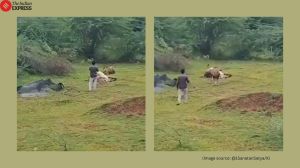Heavy encroachment, unregulated construction, and blocked natural drainage identified as major causes behind the disaster
Civil Society Group Himalayan Niti Abhiyan submits report to MoEFCC; State government
 The preliminary assessment prepared by environment activists Hem Singh, Rajneesh Sharma and Guman Singh concluded that at least seven people were confirmed dead, while 21 remain missing. (Photo/PTI)
The preliminary assessment prepared by environment activists Hem Singh, Rajneesh Sharma and Guman Singh concluded that at least seven people were confirmed dead, while 21 remain missing. (Photo/PTI)A preliminary assessment by the civil society group Himalaya Niti Abhiyan has revealed catastrophic damage caused by the torrential rains and subsequent flash floods and landslides that struck the Seraj Valley in Himachal Pradesh’s Mandi district on the night of June 30, 2025.
The group, which released its report Tuesday, attributes the scale of destruction not only to natural forces but also to unchecked construction in fragile ecological zones, encroachments on watercourses, and a lack of disaster preparedness. Himalaya Niti Abhiyan has been working to protect Himalayan ecology, flora and fauna in the state for the last two decades.
“The report is based on field visits and local inputs gathered by the group’s volunteers, as the Himachal Pradesh government is yet to release official figures. Over 50,000 people across a 35-40 km stretch—from Magru Gala to Pandoh Dam—were affected after relentless rainfall beginning June 29 led to the overflowing of streams and widespread landslides in the Bakhli-Nal valley”, Guman Singh, office bearer, Himalaya Niti Abhiyan, said. He said that the report has been shared with the central and the state governments, and MoEFCC.
The report states that “Thunag, once a quiet village, has transformed into a regional hub over the past few decades. However, much of this development occurred in and around natural drains and ravines, which had seen repeated flooding episodes in the past. This time, the waters reclaimed their original course, devastating the town. Nearly 50 percent of Thunag Bazaar was destroyed, leaving 120 shopkeepers jobless. The local administration has been slow in clearing debris, halting commercial activity. Many traders are now trying to rebuild their shops from scratch.”
The report stated while attributing the old revenue record and testimonies of aged people, “About 40 to 50 years ago, there were only 20–25 traditional watermills (gharats) in the villages of Thunag. At that time, the only major road was the Mandi–Janjehli route. In 1984–85, Thunag was granted tehsil status, followed by the establishment of a senior secondary school and a sub-division of the IPH (Irrigation and Public Health) Department. Over the past few years, roads have been built connecting every village. Several government institutions and office buildings have been established in this valley, including the Panchayati Raj Training Centre, the SDM office, a mini-secretariat, a court, a bus stand, the Jal Shakti Department’s divisional office, a horticulture college, and more.”
The report further adds, “Gradually, the traditional watermills (gharats) and small water channels (kulhs) around the entire valley were sold off, and houses and shops began to be built in the surrounding fields. In this way, encroachment slowly occurred along all the nearby streams and valleys. Thunag has experienced floods three or four times in the past as well, but this time the water seems to have truly reclaimed its natural path.”
it states, “Massive landslides were reported across forested slopes from Magru Gala, Raigarh, and Shikari Mata to Kalhani and Bakhli, with hundreds of hectares of forest land impacted and thousands of trees lost. Streams and riverbanks have eroded, wiping out vegetation and altering landscapes. The forest department is yet to assess these losses.”
The preliminary assessment prepared by environment activists Hem Singh, Rajneesh Sharma and Guman Singh concluded that at least seven people were confirmed dead, while 21 remain missing. Approximately 50 others were reported injured, and over 300 domesticated animals perished in the disaster. Several houses collapsed, while others were buried under debris.
Over two dozen villages, including Railchowk, Bhalward, Baiod, Pandav Shila, Thunag, and Sharan, were severely affected. In many remote hamlets, the scale of damage is still unknown as they remain inaccessible.
The assessment of damage was estimated that 622 homes and 350 cowsheds were completely destroyed; 150 houses were partially damaged; thousands of bighas of farmland and apple orchards were obliterated by landslides, along with numerous polyhouses used for floriculture; in Thunag town, one of the worst-hit areas, 150 commercial establishments suffered losses—around 60 shops were completely swept away, while 40 others were damaged by mud and debris. Public offices, banks, and legal chambers were also impacted.
The valley’s road network was devastated include Major roads including Chail-Janjehli, Lambathach-Kalhani-Pandoh, and Lambathach-Chiuni-Shetaadhar remained blocked for days; the Janjehli-Gadagussaini road sustained severe damage, and many bridges were washed away, cutting off access to several villages.
Apart from these, other key infrastructure losses include Patikari hydro project (13 MW) was completely destroyed; a major lift water supply scheme (Chhadi Khad-Shetaadhar), catering to 25 panchayats, was rendered defunct, creating a drinking water crisis. Several other rural water schemes were damaged; over a dozen villages are still without electricity, even a month after the event; schools and public buildings in many areas were heavily damaged.
In a joint statement, the group members stated, “Despite the enormity of the disaster, the state government has not released an official damage report. Himalaya Niti Abhiyan has urged the revenue and forest departments to carry out a detailed, transparent assessment to ensure that no affected family is left without compensation or relief. The group estimates total losses—public and private—across Seraj Valley to be in the range of Rs 500 crore, with Thunag alone accounting for Rs 100–Rs 150 crore loss.”












